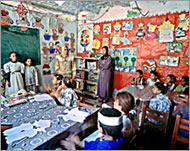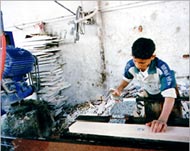Trading childhood for an income
Every morning, nine-year-old Aya takes the sardine can public bus from the working-class suburb of al-Marj in northern Cairo to the central Tahrir Square.

There, she alights at a usually traffic-jammed area on the 6 October Bridge to sell whatever she can to passengers in passing cars: tissues, flowers “and sometimes newspapers”.
She stays on from nine in the morning “until about six, and then I take the bus and go home”.
On a good day, Aya, who has never been to school, says she makes about $1.50 adding that she needs the money to help her mother, a widow, and her five brothers and sisters.
“I bring the money and my elder sister cooks for us,” she says in her dirty white dress, trying to sell me a box of tissues.
Several other children, aged between nine and 17, also walk among slowing-down cars under a merciless sun, selling the same goods.
They are exposed to many kinds of dangers: from being run over by a car, to arrest and abuse by police and other authorities.
“We get chased sometimes by juvenile police and municipality authorities,” says 16-year old Mahmud Abd Allah. “We just run, and keep running until they lose our track.”
Disputed figures
In 1986, the Egyptian government conducted its last official survey on child labour and estimated the number of working children to be around 1.4 million.
The government recently said that the number has dropped to 600,000, but non-governmental organisations (NGOs) dispute this figure.
|
“What the government has done is exclude children working in the agricultural sector, who represent the majority of working children” Mahmud Murtada, |
“This is untrue,” said Mahmud Murtada, executive director of the Centre for Studies and Programmes of Alternative Development, a Cairo NGO.
“What the government has done is exclude children working in the agricultural sector, who represent the majority of working children,” he told Aljazeera.net.
Muna Sadiq, director of the Working Child Centre, said the average figure of working children in Egypt is about 2.2 million, about nine percent of the nation’s workforce.
“But it’s still hard to get accurate numbers because some children, especially in agriculture, work in specified periods during the year,” she added.
According to the 1986 survey, 78% of working children make their living harvesting cotton and different crops, while others are scattered among several professions such as tannery, pottery, car repair and other menial jobs.
Economic factors
The main reason behind the rise of child labour in Egypt, argues Safwat Qabil, a Cairo University Economics professor, is the country’s struggling economy and the rising cost of living.
According to the World Bank, the 2002 Gross National Income (GNI) per capita in Egypt is $1470. Official statistics estimate unemployment to be around 10%, although the figure is thought to be higher.
 |
|
Poverty and rising living costs |
“Whenever prices go up, child labour increases,” Qabil told Aljazeera.net. “In such circumstances, the private sector goes for a workforce that does not cost them any type of social security and other financial obligations.”
The same reason, explains Qabil, makes attempts and promises by the government to crack down on child labour unrealistic.
“When the whole economic scene improves, then we can talk about a drop in child labour,” he said.
Qabil’s assessment is bad news for the Egyptian government.
In 2000, the then-US president, Bill Clinton, called on the World Trade Organisation (WTO) to sanction member countries that use the most severe forms of child labour.
Egypt was among the countries that opposed the proposal, accusing Clinton of using moralistic language to cloak protectionist policies aimed at restricting imports from Third World countries.
“Despite sanctions not being applied, developing countries including Egypt feel that their exports to developed countries could face more strict custom barriers due to their use of the child labour which makes their goods less expensive and more competitive,” Qabil said.
Poor education
Education, or the lack of it, also plays a major role in the incidence of child labour, experts say. They point out that along with the rising number of working children comes a corresponding high school dropout rate.
“Education has lost its value as a means to climbing the social ladder due to its rising costs, the over-crowded classrooms and the lack of job opportunities for educated people,” argues Abd al-Basit Abd al-Muti, a prominent sociologist.
 |
|
Underfunded schools struggle to |
The government blames the deteriorating state of public schools on lack of funds, while it is constitutionally obliged to provide free educational services.
Abd al-Mouti, however, said expenses such as private tuition made education in Egypt “anything but free”, forcing many families and children to leave school.
“They spend a lot of money on educating their children, who eventually can only work in agriculture owing to the lack of job opportunities,” he told Aljazeera.net.
“Losing children to work because of the deteriorating value of education due to economic reasons is a condemnation of the government’s development policies. People are the country’s best resource,” he added.
A 1999 study conducted by Murtada’s CSPAD showed that 70% of the children working in pottery shops were illiterate, while the others were performing much worse than normal schoolchildren because of their “tough working conditions”.
Dangerous jobs
The study included 500 children between the ages of six and 14 who worked an average of 12 hours a day preparing the clay, handling the heavy clay lots to their masters, and standing in front of the hot oven waiting for the final product.
According to Murdata’s study, children working in pottery shops make between $2.40 to $6.40 per week.
The dangerous nature of their job, Murtada says, violates both international and Egyptian labour laws that put the minimum employment age at 14.
 |
|
A 1986 study puts the number of |
Even child between 14 and 16 years of age, the law stipulates, should not work more than six hours “and not in dangerous activities or activities requiring heavy work”.
Violators, however, are subject to only a $15 fine per child.
A police official at the Juvenile Delinquency Department said that enforcement units raid shops and fine violators. However, he said police take into account the children’s desperate need to work and support their families.
But ineffective legal punishment and law enforcement leave the children subject to all kind of abuse by their employers, including sexual harassment and drug addiction.
Sexual abuse
Sadiq said that among 250 children visiting her Working Child Centre, there were several sexual abuse cases “especially among those working as assistants to microbus drivers”, while Murtada revealed that several children working in pottery shops have experimented with marijuana.
Police are also accused of mistreating children. And although a Human Rights Watch report in 2003 focused on what it described as police’s mistreatment of street children, many of those, like Aya, are actually considered working children.
|
“They are more vulnerable to conduct disorder, insomnia and depression” Khalil Fadil, |
Mushira Khattab, secretary-general of Egypt‘s National Council for Childhood and Motherhood, told a recent conference on street children that her organisation was training police and judges to deal with street children “as right holders, not as criminals”.
The harsh working circumstances and occasional abuse make the children more “vulnerable to psychological disorders” than others in the same age, argues Khalil Fadil, member of the London Royal Psychiatrists’ College.
“They are more vulnerable to conduct disorder, insomnia and depression,” he told Aljazeera.net, “because the time that they should spend playing and developing their psychological side is used in work.”
And despite help offered by NGOs to better the children’s lives and train them to acquire better learning and vocational skills, they have little chance to recover, Fadil explains, unless their circumstances change significantly.
“Therapy has limited results in such cases, as the causes of the disorders usually remain unchanged.” he said.